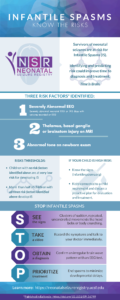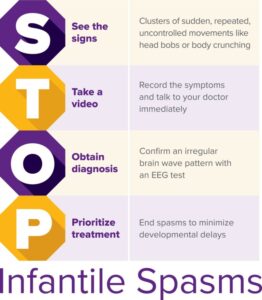HIE is the second leading cause of Infantile Spasms, a dangerous and emergent seizure and form of epilepsy. Left untreated or undertreated, IS can cause developmental regression and even additional brain damage.
Hope for HIE is working to further educate our community on the importance of accurate and quick identification, aggressive treatment, and follow up care to ensure our children have the best possible outcomes.
Through the Child Neurology Foundation, many resources are available for families and practitioners about Infantile Spasms.
Hope for HIE is a member of the Infantile Spasms Action Network, working collaboratively with other organizations and researchers to raise awareness for Infantile Spasms, and the Neonatal Seizure Registry.
Each year, many organizations come together to promote awareness for Infantile Spasms through ISAW. In 2019, Hope for HIE worked with two leading pediatric neurologists, Hannah Glass, MD and Adam Numis, MD, both whom serve on Hope for HIE’s Medical Advisory Board, to further educate our community through ISAW.
 HIE itself places a child at higher risk for Infantile Spasms. However, there are certain attributes of a HIE diagnosis that may further increase the risk:
HIE itself places a child at higher risk for Infantile Spasms. However, there are certain attributes of a HIE diagnosis that may further increase the risk:
Typical onset of Infantile Spasms is between 4-8 months, and the onset is considered a medical emergency. If you suspect your child has developed IS, implement the STOP for IS protocol below.
We recommend all HIE families find out the best way to send over videos of concerning movements to their medical team to proactively have a plan for evaluation, should the need arise.

Know the signs to ‘STOP’ Infantile Spasms. Identifying spasms is critical for parents, caregivers and providers.
Connect with families, read inspiring stories, and get helpful resources delivered right to your inbox.